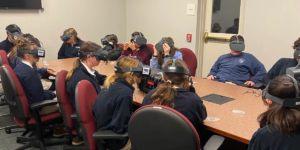By Andrew Adler
Community Editor

Students from Lexington’s Mary Queen of the Holy Rosary school wearing virtual-reality headsets gather around a table at the Scott County Library to view Parker Friedman’s VR Holocaust narrative (photo courtesy of Craig Friedman)
It is a gray, cheerless winter day. A road stretches in front of you, covered in snow, as are the seemingly endless rows of low-slung buildings clustered on one side. In the near distance there is a gate bearing the words Arbeit macht frei – Work sets you free.
You have arrived at a place of murderous infamy. You have arrived at Auschwitz.
But you are not physically there. Instead, you are sitting in an ordinary chair in an ordinary room, with a device resembling oversized ski goggles strapped to your face. Ahead, behind, to the left, to the right – wherever you look, a different perspective is revealed. You stand next to three women, death camp survivors, as each recounts the daily horror that was Auschwitz. A few minutes later, you sit across from an elderly man who tells you a story of how family’s beloved dog somehow transcended the despair of life in a Nazi-controlled Polish ghetto.
It is a Holocaust narrative rendered in virtual reality, brought to you by an ingenious 17-year-old high school junior named Parker Friedman.
Friedman, who attends duPont Manual, is a young man who plays football (a placekicker who dabbles in punting) and is a keen observer of the world around him. As he became increasingly aware of anti-Jewish sentiment, he also realized that too many Kentucky teenagers have only the barest knowledge of the Holocaust.
He was determined to, literally, change that reality.
“I’m a big history buff,” he says, “and I saw rising antisemitism in the US and around the globe. I was watching 60 Minutes and there was a segment on the USC Shoah Foundation and their virtual reality (installation), which I thought was pretty cool. Up in Chicago my family and I went to the Chicago Holocaust Museum, and I saw their virtual reality exhibit – a really immersive experience – which inspired me to bring it to Kentucky.” Those encounters also prompted him to create his own website: historicalreality.org, whose mission is “Bringing history to life by providing educators and students with immersive virtual reality content and equipment.”
Friedman was not exactly a virtual reality neophyte – he once owned a VR headset – “but I wasn’t familiar with the educational benefits until I saw the USC Shoah exhibit and the 60 Minutes segment. Then it made complete sense to me. And it just took off from there.”
With input from Louisville Holocaust educator Fred Whittaker and the University of Kentucky’s Holocaust Education Initiative, Friedman set to work. Through Facebook, he connected with entrepreneur Shel Mann, CEO of Firefly VR, a Minneapolis-based company that specializes in adapting virtual reality to the needs of healthcare. Firefly has donated more than 50 surplus VR headsets, each of which is now programmed with an approximately 20-minute presentation.
“Parker’s creation embraces the idea that the great wisdom of the Shoah is multifaceted,” says Whittaker, who teaches at St. Francis of Assisi Catholic School. “Much of it can be taught using maps, diagrams, and narration. But much of its wisdom — perhaps its greatest wisdom — remains beyond the scope of words.”
Its main component is Inside Auschwitz, a nine minute, 37 second “virtual reality documentary” produced by the German broadcasting service WDR in 2018. The documentary provides viewers with a 360° drone-photographed tour of the extermination camp, and includes testimonies from Holocaust survivors Anita Lasker-Wallfisch, Philomena Franz and Walentyna Nikodem.
“It’s not easy to explain to a normal person what it was like in Auschwitz,” says the narrated introduction. “Because you didn’t believe you would ever get out of there. In Auschwitz, everything you can imagine happening as a result of insane, evil human behavior took place.”
Friedman’s presentation then segues from the pangs of despair to a declaration of hope via Lala, in which survivor Roman Kent “shares his story of a dog in Nazi-occupied Poland who taught him a timeless lesson: that love is stronger than hate.” Here, VR mingles Kent’s live testimony with animated sequences in which Lala (“doll”) demonstrates unwavering devotion to her beleaguered family.
Next comes a USC Shoah Foundation interview with survivor Betty Gold, who tells how, through mere chance, her family escaped being executed by Nazi sympathizers. She recalls her father saying:
“Look, when they come here to kill us, this is what we’re going to do. Don’t wait. Get out and run. You’ll get hurt on the run; you’ll get shot — but if they find us alive they’ll cut us to pieces. Let them shoot you in the back; let them kill you, but don’t stand there. And if anybody survives, we’ll meet there, there, and there.”
Last, and perhaps most immediately resonant, is #WeRemember, produced jointly by the Foundation and the World Jewish Congress.
“Man is capable of terrible things,” says survivor Henia Goldman, “and at the same time, man is capable of very noble things.”
“Because the Nazis are gone doesn’t mean that evil is gone in this world,” warns survivor George Papanek. There are recollections of genocide against Armenians, Rwandans, and other ethnic groups. We are challenged not simply to remember, but to confront such wrongs whenever and wherever we find them, to give true meaning to the phrase, Never again!
Friedman has organized demonstrations of his VR presentation for educators and has taken it to various classrooms around the state, and such locations as the Scott County Library, where student groups visited the United States Holocaust Museum’s traveling exhibit, Americans and the Holocaust.
Whittaker was a key resource in molding what became the eventual VR package. “He allowed us to pilot it in his classroom,” Friedman says, “and we got great feedback from the students that allowed us to improve our program before we rolled it out to more schools. We’ve had kids from Hazard come in, kids from Louisville — from throughout the state.”
“The experience was breathtaking,” Whittaker recalls. “My students learned in ways which could never have occurred without their visit into the setting, which defines the Holocaust’s greatest darkness, and creates some of that most powerful wisdom.”
“Mr. Whittaker was really helpful,” Friedman says, “especially with how to format it to make sure that it tells a story. The goal, especially with the last (segment), was to bring it all together into the modern day.”
Asked how students typically react to the material, Friedman said that before the presentation, “some of them might be laughing and joking, but at the end, it’s all quiet and nobody’s talking. Everybody’s just processing what they just saw. I think that shows how impactful it is.”
Impact is something Friedman appreciates first-hand. Last year, as the rain poured down, he and his family visited Auschwitz.
“It’s massive,” he says. “I had no clue before I went how big the actual camp was. But seeing it beforehand in virtual reality, I felt like I’d actually been in the places where I was now standing.”
“The Shoah’s lessons are spoken into our souls,” Whittaker says. “It is in this sacred space, in the geography of emotional landscape, where we learn some of life’s most important lessons. So many people will never be able to travel to the killing fields in Poland — most will never be able to visit Auschwitz. They can now through Parker’s virtual reality, in a way that transcends what a teacher could ever do.”
Indeed, “Holocaust educators ultimately hope that their students will be changed by what they encounter in the classroom,” Whittaker emphasizes. “They hope the arc of their being will be bent towards compassion and justice and mercy. Bearing witness in the way that Parker’s device allows is the closest thing to visiting. It blesses all who use it with the opportunity to create the kinds of interior journeys which allow us to learn with our hearts.”




